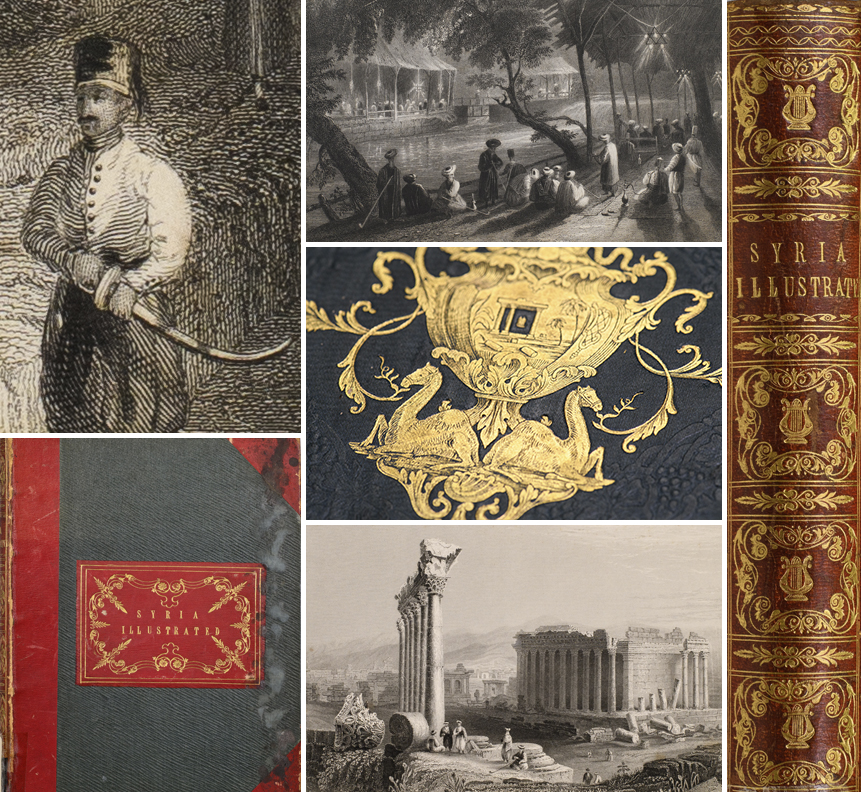
Photographer’s note: Due to the fine linework that exists in these engravings, more specifically sky renderings, there will often be times where the photographs taken display moiré patterns. When viewing these engravings with the human eye, these areas would normally look like shading or tonal changes, but due to the shape of the light sensor on a DSLR (which projects a grid pattern) and that we often have to shoot images at a slight angle (we utilize foam cradles for the safety of these items), this type of fine linework can appear “wavy” due to pattern overlap. In photography this effect is referred to as the moiré pattern. If you would like to learn more, check out this article about moiré by Nikon USA.
Introduction
Syria, The Holy Land, Asia Minor &c., Illustrated in a Series of Views Drawn from Nature by W.H. Bartlett, William Purser and Thomas Allom. With Descriptions of the Plates by John Carne first appeared, in parts, between 1836 and 1838. Published by Fisher, Son & Co, London, Paris & America, it marked another entry in a string of works by Carne that documented his extended travels outside of England. Starting in 1826, with his Letters from the East, the next decade would see a number of single and multi-volume publications ranging from The Exiles of Palestine: a Tale of the Holy Land (1831) to Letters from Switzerland and Italy (1834). What made the 1836 publication different, however, was its extensive use of illustration. Returning to the title page (image 1), it is worth noting the priority given to the artists. This is a work that is illustrated first and described second. Such reliance on a team of artists for topographical works of this period is not uncommon and yet we can easily ignore their importance when we start, as I did at the beginning of the post, by positioning this printed work as one of Carne’s creations. In fact, the illustrations were an essential reason as to why this book sold in the 1830s and why it continues to attract book buyers today. So, let’s begin with the art.
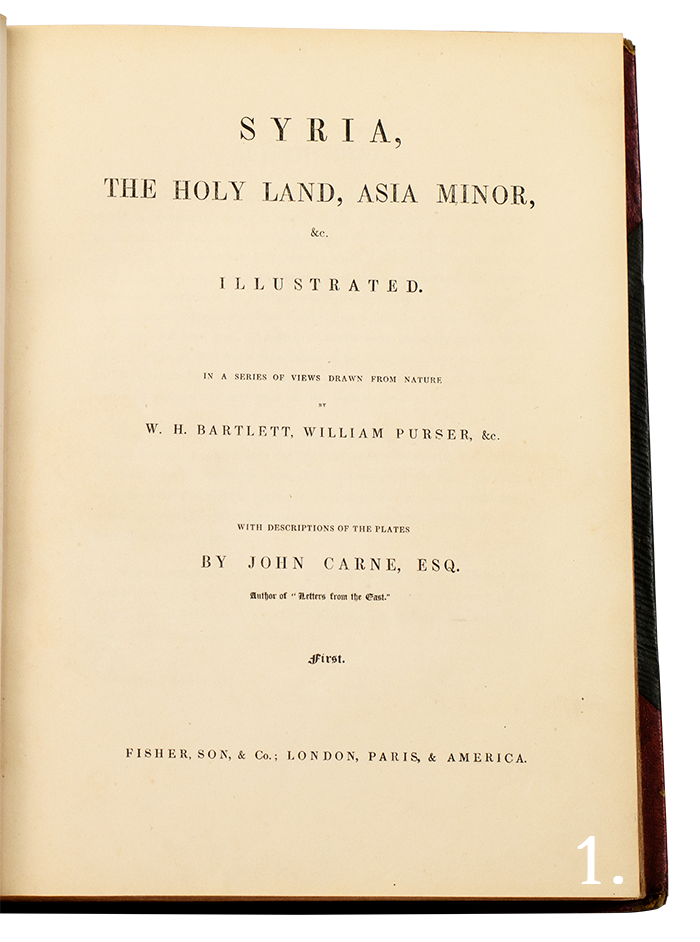
The Engravers
Syria, The Holy Land, Asia Minor &c., Illustrated in a Series of Views Drawn from Nature includes more than 120 steel line engravings. Most of the illustrations were based on original watercolours produced by William Henry Bartlett (1809-1854). Following years as an apprentice under John Britton (1771-1857), Bartlett would travel extensively between the 1830s and 1850s, creating illustrations explicitly to be produced as engravings.[1] In fact, if we look closely at one of the earliest illustrations in volume 1 [Ruins of Balbec] (image 2) we can see the collaboration at work. “W.H. Bartlett” appears in the bottom left corner, while “J. Sands” name appears in the bottom right. In other words, Bartlett produced the original drawing which Robert Sands (1782-1855) then engraved into steel.[2] While it would be easy to dismiss Sands as a kind of secondary assistant, as one who just transfers the genius of Bartlett, we might think otherwise when we consider the technical skill and time required to engrave an image of this quality. Engravers used a tool known as a burin to carve lines into metal plates which would then be inked on a rolling/intaglio press. From the late sixteenth century to the early nineteenth century the dominant medium for such engravings was copper, but from 1820 to 1840 publishers increasingly switched to steel as the plates could be used for a larger number of impressions. In the example shown here we can begin to appreciate the potential of steel engravings for capturing detail, as in this separated capital from one of the columns, or the facial expressions of locals. Such detail should also attune us to the labour involved in such creations. While Bartlett produced most of the illustrations for volume 1, the execution of his art into steel depended on a small army of some 56 forgotten artists.
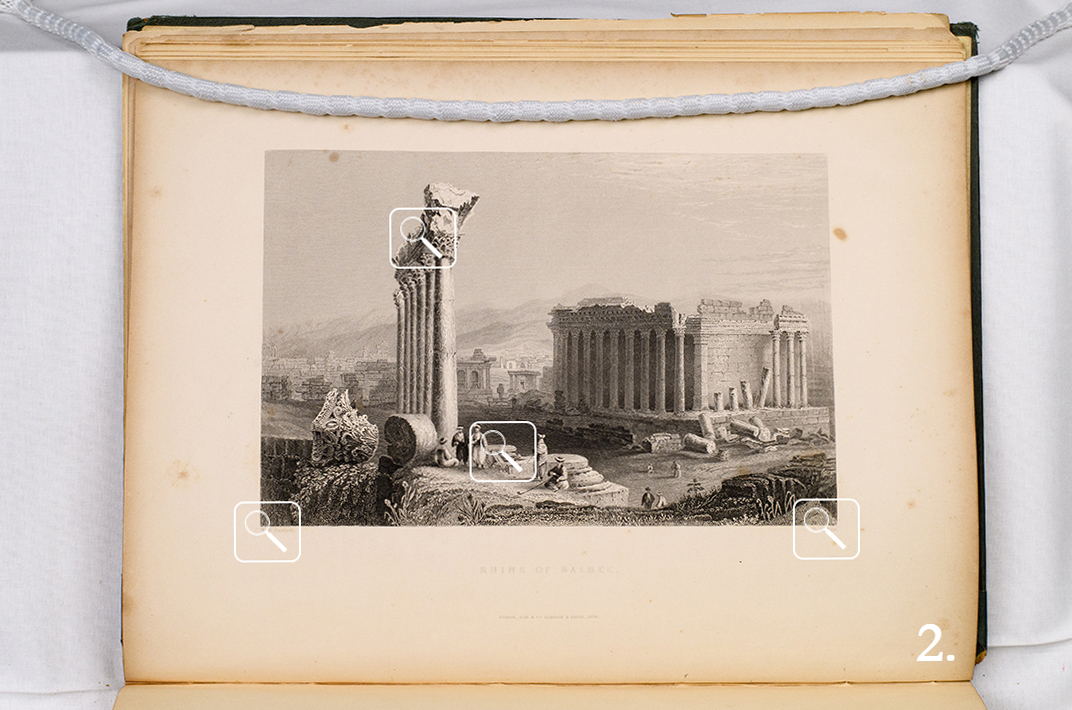
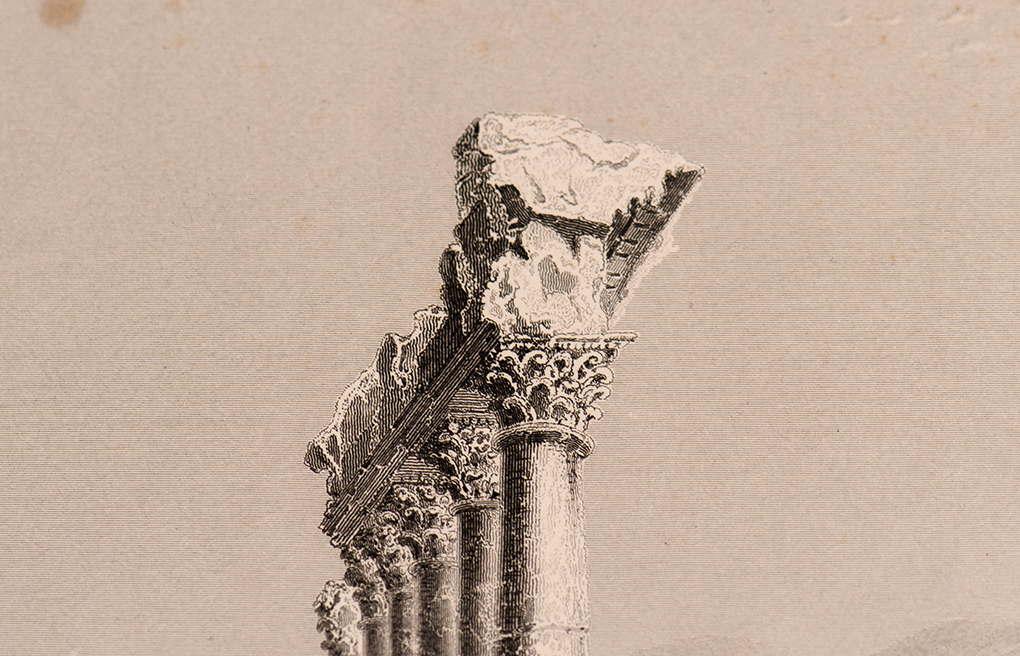
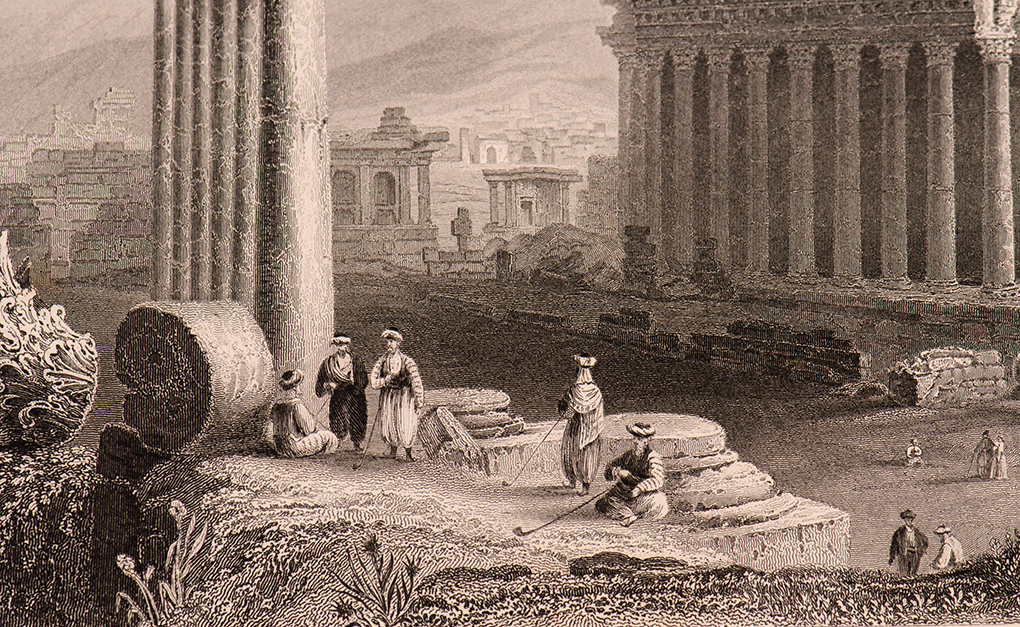
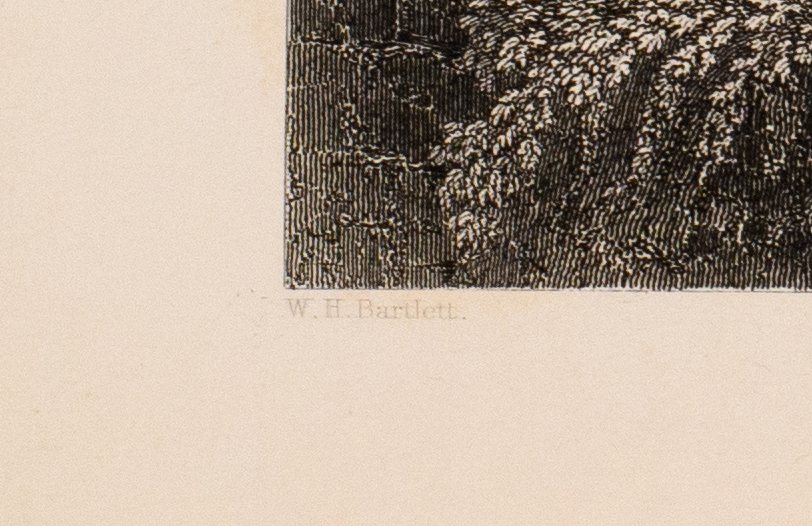
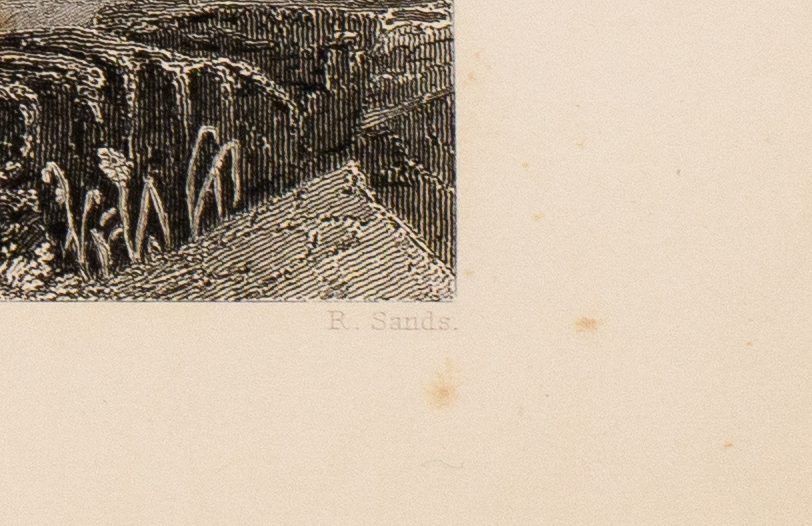
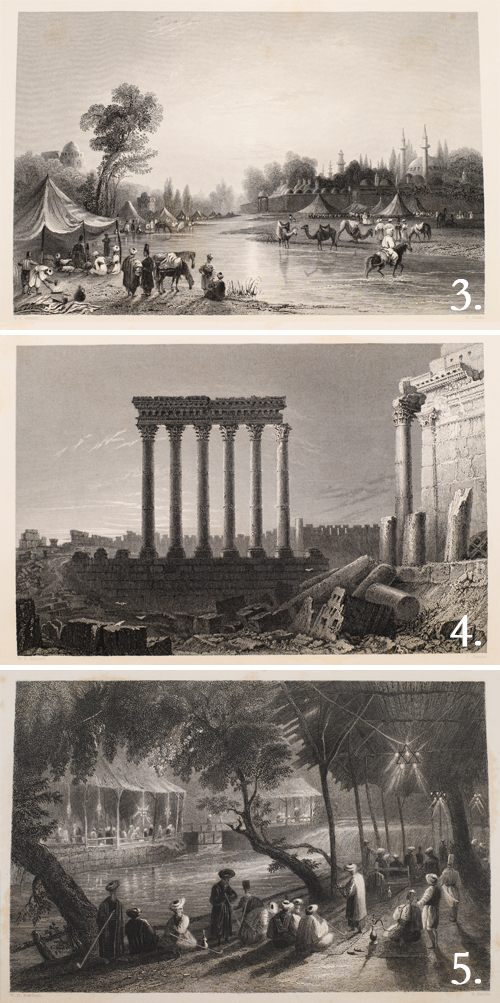
A closer look at the first volume of Syria, The Holy Land, Asia Minor &c. allows us to appreciate this distribution of labour among the engravers.
Volume 1 – Title-page – H. Adlard
Fall of the River Cydnus – E. Benjamin
Ruins of Balbec – R. Sands (image 2)
A Turkish Divan – Damascus – G. Presbury
Village of Eden – W. H. Capone
Tarsus – J. Carter
Junction of a Tributary Stream with the Orontes – W. Finden
Antioch from the West – J. Jeavons
Scene of the River Orontes, Near Suadeah – T. Higham
Tripoli – J. C. Varrall
Antioch on the approach from Suadeah – J. Redway
Beteddein – Palace of the Druses – W. Floyd
St. Jean D’Acre – Mount Carmel in the Distance – T. Barber
Beit El Ma, Near Antioch, Supposed Site of Daphne – H. Adlard
Adana, Mount Taurus in the Distance – W. Finden
The River Barrada, The Ancient Pharpar – J. Sands (Image 3)
Six Detached Pillars of the Great Temple at Balbec – J. Sands (Image 4)
Pass of Beilan, Looking Towards the Sea – S. Bradshaw
The Mouth of the Nahr-el-Kelb – J. W. Lowry
Scene in Mount Lebanon – M.J. Starling
Gothic Castle in Valley Near Batroun – W.J. Cook
Ancient Cedars in the Forest of Lebanon – J. Redaway (only in Huron copy).
The Great Khan at Damascus – W. Kelsall
Fortified Cliffs of Alaya – Coast of Caramania – H. Adlard
Rhodes – W. Wallis (only in Huron copy).
The Pass of Beilah – Mount Amanus – J. Tingle
House of Girgius Adeeb, At Antioch – T. Dixon
Der-El-Kamar and the Palaces of Beteddein – T.A. Prior
Part of the Walls of Antioch, Over a Ravine – S. Lacey
Lebanon – J. Redaway
Coast of Asia Minor, Near Anamour – J. Tingle
Cafés in Damascus – S. Smith (Image 5)
Kalendria – Coast of Cilicia – W. Taylor (only in Huron copy).
The Village of Zgarti – A. H. Payne
Pass in a Cedar forest Above Barouk – J. H. Kernot
Mount Casius from the Sea – H. Jorden
This list reminds us of the collaboration at play in the illustrating of works from this period. While the names of the engravers are entered at the bottom right of each illustration, it is easy to ignore them. In fact, most library catalogue records include a reference to Carne, Bartlett and the other “artists,” but the engravers go unmentioned, despite the availability of secondary, biographical resources.[3] To be fair, to create authority records for the many engravers found in all the illustrated works of this period would be extremely time consuming. Having said that, if we are to adequately capture the making of any book, we must, in true Darnton fashion, acknowledge all of those who participate in its creation.[4] Taking account of the engravers is also important as each artist brings a unique stamp to the transfer process. In fact, as we survey the illustrations in Syria, The Holy Land, Asia Minor &c. one experiences a range of different tonal effects. Some images are quite light while others are darker, and this is in large part a result of the depth of lines in the engraving. To take but one example, consider the differences between “A Turkish Divan. – Damascus” (image 6) and “Gothic Castle in a Valley Near Batroun” (image 7).
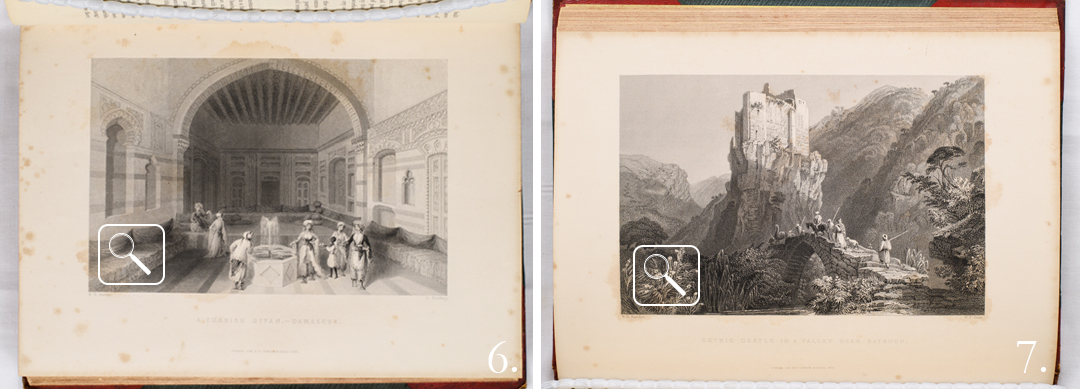
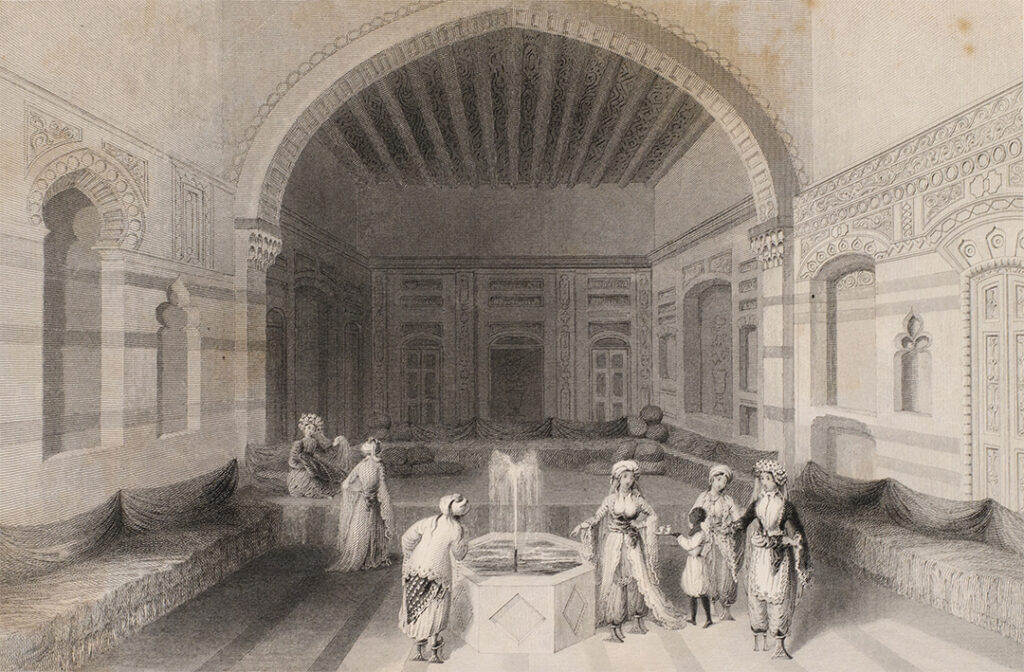
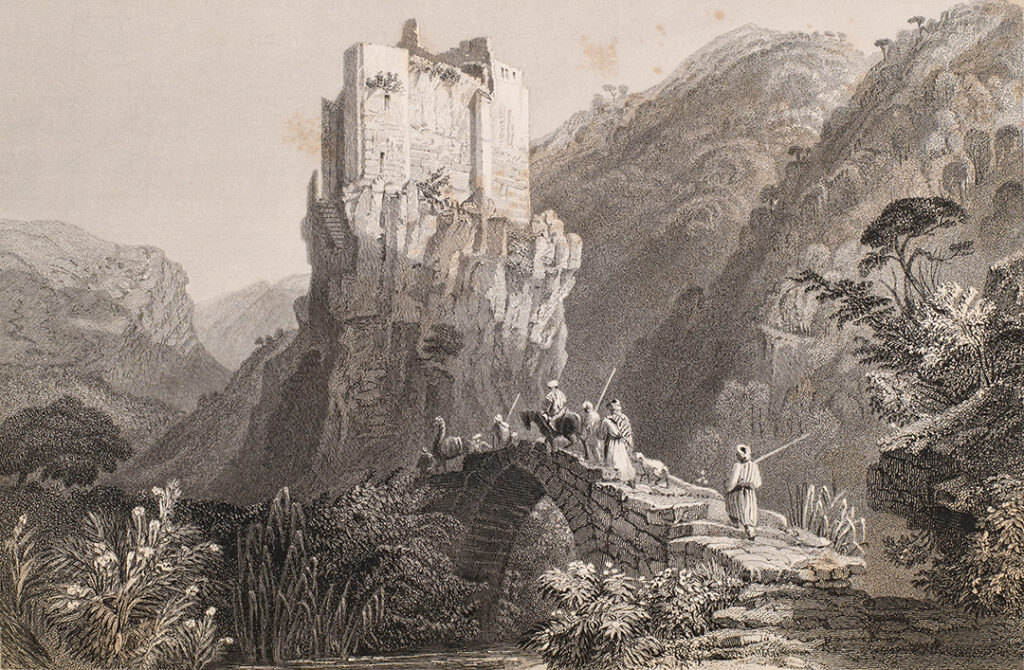
[1] Bartlett produced 107 of the 120 drawings while in the Middle East between 1834 and 1835. For more on Bartlett and his work on Syria, The Holy Land, Asia Minor &c., see Basil Hunnisett, Steel-engraved Book Illustration in England (London, Scolar Press, 1980), pp. 109-120. For a larger treatment of Bartlett’s life and work, see Alexander M. Ross, William Henry Bartlett: Artist, Author and Traveller (Toronto: Toronto Press, 1973). |Back to section
[2] Bartlett’s original watercolour of a “Village of Bruhanna in Mt. Lebanon” is at the Victoria and Albert Museum and is digitized here: https://collections.vam.ac.uk/item/O137382/village-of-brumhanna-in-mt-watercolour-bartlett-william-henry/. It would appear in Volume 2 of Syria, The Holy Land, Asia Minor &c. and was engraved by J. Redaway. |Back to section
[3] Biographies for each of the engravers can be found in Basil Hunnisett, A Dictionary of British Steel Engravers Leigh-on-Sea, F. Lewis Publishers, 1980. Several of the engravers are also included in the ODNB. For a rare exception in catalogue entries, see the detailed record for the copy at the Thomas Fisher Library at the University of Toronto: https://librarysearch.library.utoronto.ca/permalink/01UTORONTO_INST/14bjeso/alma991106092227006196 |Back to section
[4] The famous Darnton circuit appears in Robert Darnton, “What is the History of Books?” Deadelus 111:3: 1982, pp. 65-83. |Back to section
Publication Details
The publication history of Syria, The Holy Land, Asia Minor &c., Illustrated in a Series of Views Drawn from Nature is at once straightforward and muddled. There is evidence that each of the three volumes was first sold separately between 1836 and 1838. In an advertisement in The Christian Keepsake and Missionary Annual we are told that the first volume will contain “thirty-seven engravings, in quarto, handsomely bound in gilt, priced one guinea.”[5] But there is also evidence that selections of Volume 1 were made available as early as the middle of 1836. In the May-August 1836 issue of The Asiatic Journal and Monthly Register for British India, China and Australasia we get a small advertisement that notes, “The Two Parts we have seen, each containing four large engravings, price 2s. promise that the work will fulfil the most sanguine expectation could look for.”[6] Another contemporary publication similarly notes that the work can be acquired in monthly parts or as a “handsomely bound” volume.[7] There is similar evidence for the release of the second and third volumes in 1837 and 1838 respectively, and by 1840 it is common to see the sale of the three volumes as a set.[8]
Both Huron and Western own copies of Syria, The Holy Land, Asia Minor &c., Illustrated in a Series of Views Drawn from Nature. The copy held in Western storage was likely sold as a 3-volume set for it not only contains uniform bindings, but a half-title dated 1838 at the start of volume one. Bound in hard green cloth, the boards are blocked in blind with scenes of riders on camels and horses surrounded by vines of flowers and fruit (image 8). Each volume also contains gilt centrepieces of a large urn surrounded by foliage and seated camels. The spines of each of the three volumes have been covered with green tape and so obscure the original gilt lettering and ornamental designs (image 9). There are at least two copies available online with this same binding and according to at least one dealer, this is the original publisher’s cloth.[9]

As with many early printed books at Western, this copy was once owned by the Stratford Ontario Engineer and public intellectual, John Davis Barnett. On each of the volume’s front endpapers Barnett records his name with numbers 38405, 38406 and 38407 respectively and a date of “2-1916,” i.e. February 1916. He also has the added note of “by exchange with Worden.” Since Barnett donated his library of some 42, 000 books to Western in 1918, this three-volume set is one of the later acquisitions. It is also unusual to see Barnett recording an exchange of this kind.
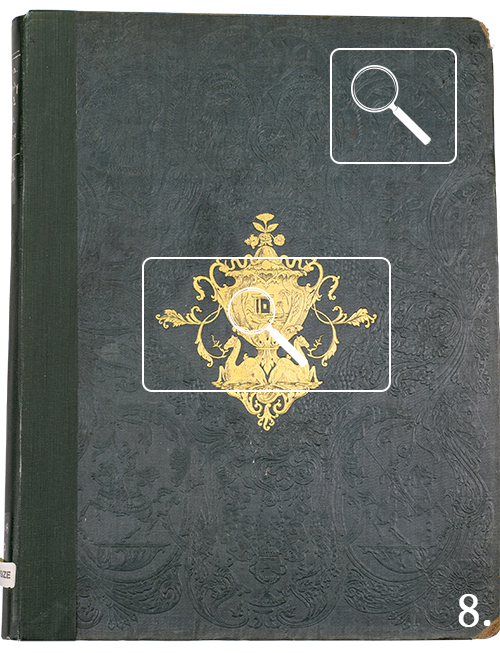
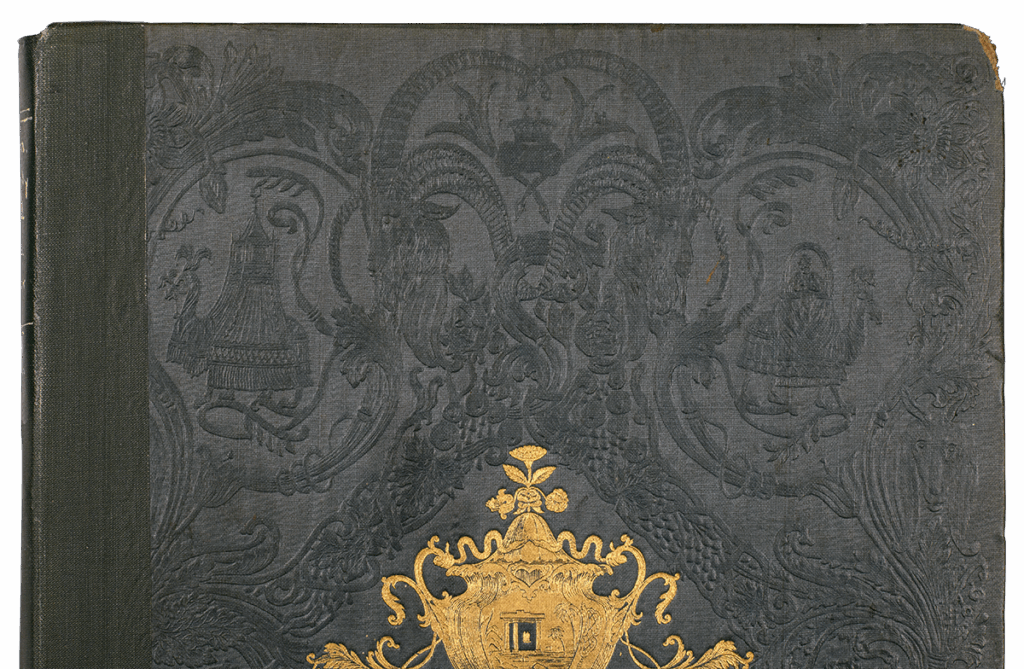
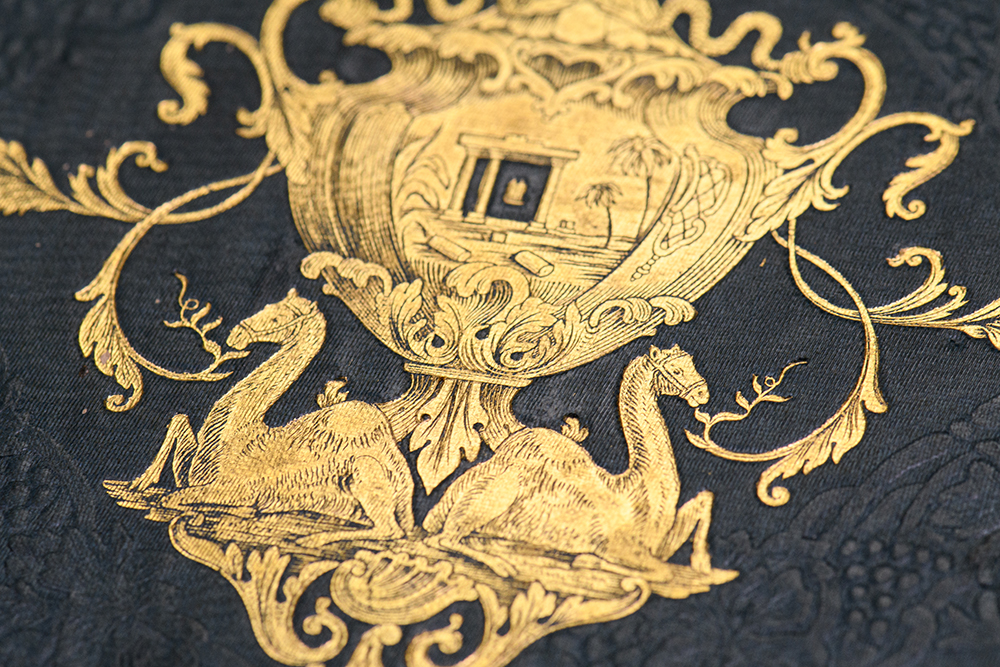
Huron’s copy is different. Purchased by the library in 1963, the copy contains all of volume 1 and 2 and pages 5-12 of volume 3 bound as a single volume in half calf over green cloth boards with speckled fore-edges (image 10). Both the spine and front board have the title “Syria Illustrated” with flowers and ornaments in gilt on a large red label. While the copy was likely rebound at a later stage, the binding of this work’s various volumes together as one is not unusual. In fact, a quick look at copies for sale in the trade show a mix of three volume sets and single, three-in-one options. But there are other differences as well. The illustrated opening title page of the Huron copy is dated 1836 (image 11) while the equivalent in the Western copy is dated 1839 (image 12). Additionally, before the title page in the Huron copy is a picture of “Damascus From Above Salahyeh,” (image 13) under tissue, not found in the Western copy. While the illustrated title page for Volume 2 of the work is the same in both the Huron and Western copies, the Huron copy lacks the half-title, Advertisement, and contents list. Finally, as mentioned above, most of part three, including the engraved maps of Asia Minor and Syria is also not present in the Huron copy.
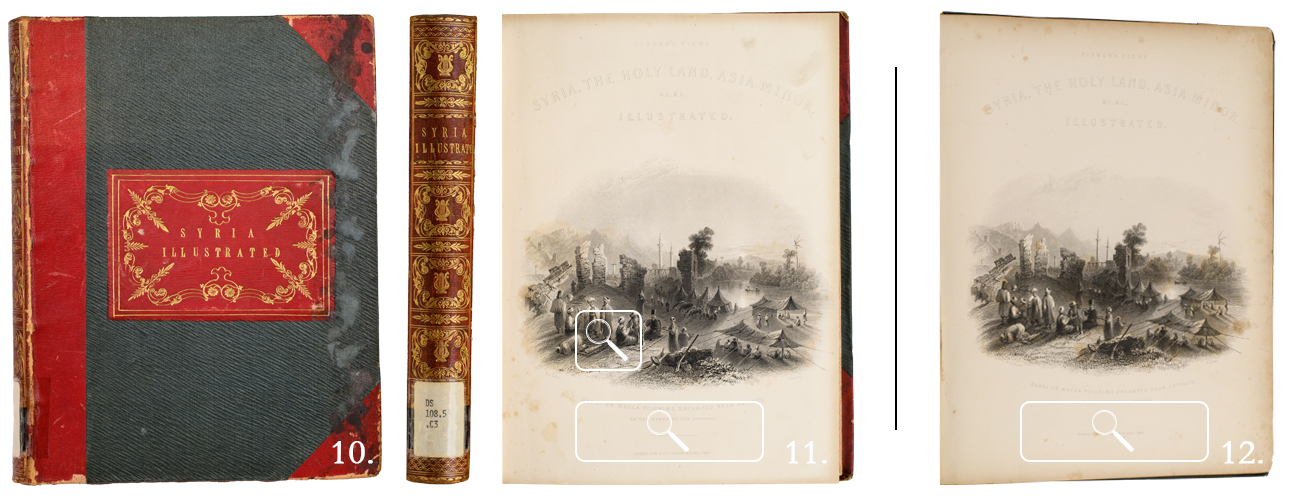

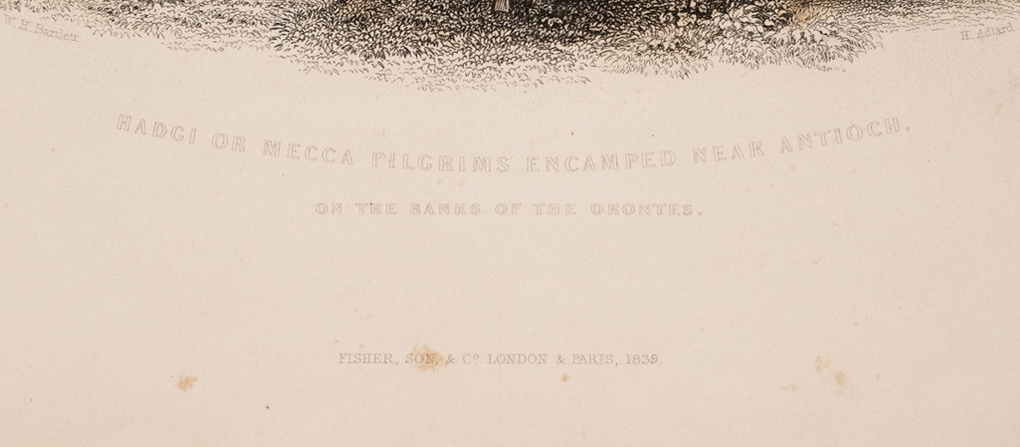
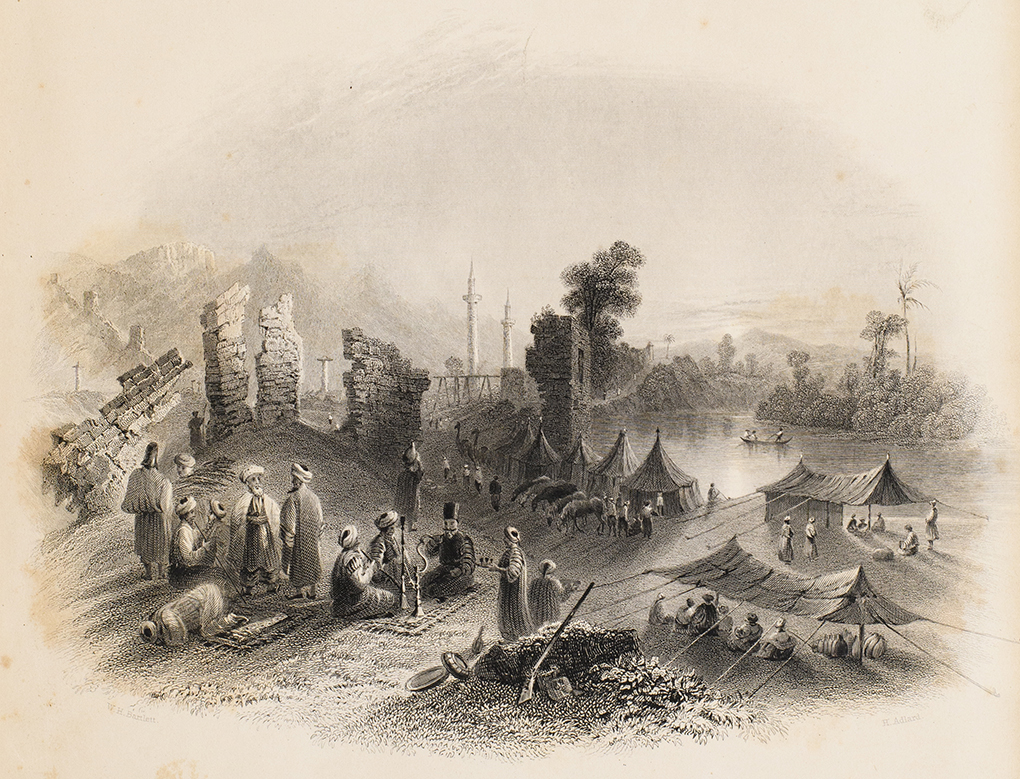
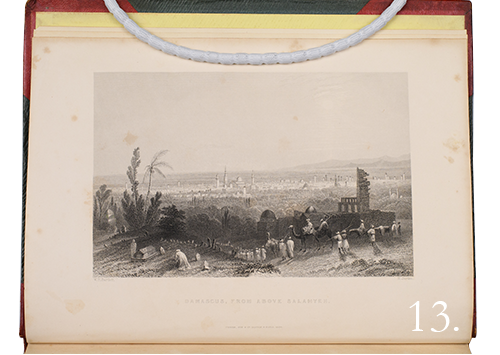
So how do we make sense of these differences? One possibility is that the Huron copy is composed of the original printed volumes as they appeared, either in parts or as whole, in 1836 through 1838. This would help explain why this copy opens with an 1836 title page while Western’s begins with one dated 1839. Huron’s Advertisement is also dated “October 1, 1836” while Western’s is left undated. Such subtle differences may appear small, but they open a window to the larger publishing history of this work. Yes, we have two copies of Syria, The Holy Land, Asia Minor &c., Illustrated in a Series of Views Drawn from Nature, but only by examining these copies in-hand, can we locate the substantive and accidental variants found in each.
[5] The Christian Keepsake (1837), p. [209]. |Back to section
[6] Vol 20, new series, May-August, 1836, p. 335. |Back to section
[7] The Literary Gazette and Journal for the Belles Lettres, Artes, Sciences, etc. No. 1049. February, 25, 1837 p. 136. |Back to section
[8] The Quarterly Review, April, 1840, p.11 advertises the set for 3 pounds 3 shillings. |Back to section
[9] A similar copy in the same green cloth of the three-volume set is available from the Paris bookdealer, Librairie Le Feu Follet. See, https://www.edition-originale.com/fr/voyages-horizons-lointains/editions-originales/carne-syria-the-holy-land-asia-minor-c-1836-79004. MW Books of Galway offers a similar two-volume set in what it describes as the “original gilt blocked cloth with gilt decorated front panels.” https://www.mwbooks.ie/pages/books/301976/john-carne/syria-the-holy-land-asia-minor-c-illustrated-in-a-series-of-views-drawn-from-nature-by-w-h-bartlett. |Back to section
Repurposing the Images
While Bartlett’s works were popular during his lifetime, many of them later fell into obscurity. One important exception was in Syria itself. As Hussein I. El-Mudarris and Oliver Salmon note, Bartlett’s images of the Old Port of Tyre (image 14) and Damascus (image 15) were used for the Syrian 10 and 25 pound bank notes in both 1920 and 1939 respectively, while individual engravings were framed and hung as art in Syrian households.[10] Today, it is not uncommon to see examples of individual Bartlett engravings hand-coloured and sold online. This is especially true of Bartlett’s illustrations of Ontario, Quebec and upstate New York for Nathaniel Parker Willis’ American Scenery (1840) and Canadian Scenery Illustrated (1842). At the current moment one can find several Bartlett prints of the St. Lawerence, Genessee Falls or St. Johns Richileau river for fifty to a hundred dollars.

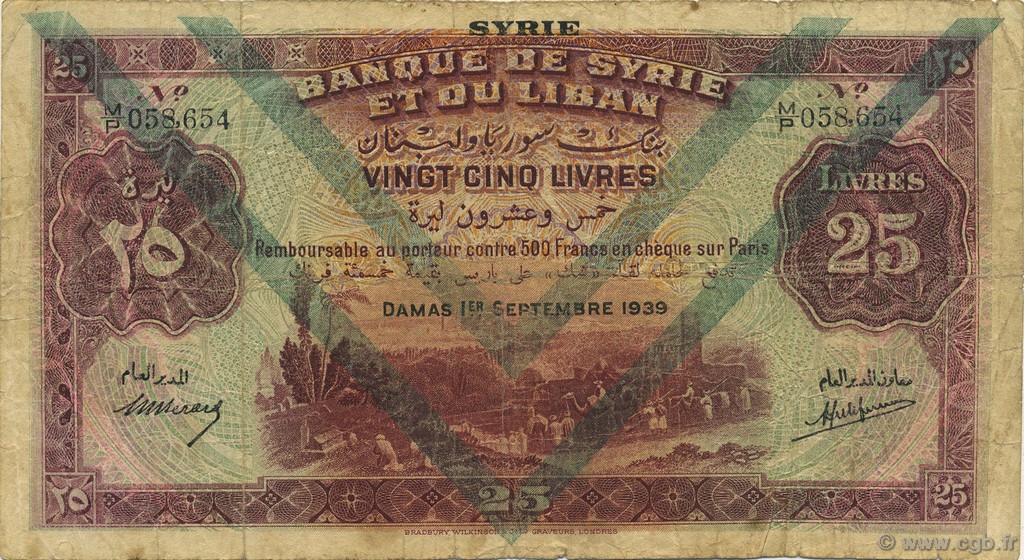
Numinista, 25 Livres, 2025. https://en.numista.com/catalogue/note245552.html
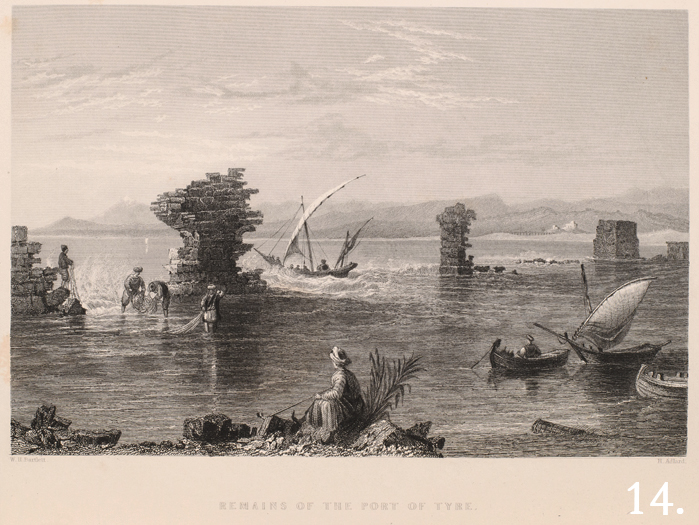
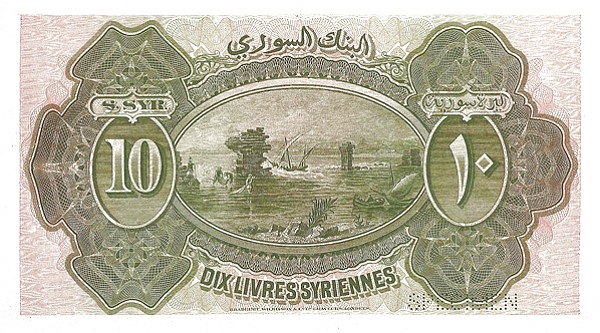
Numinista, 10 Livres, 2025. https://en.numista.com/catalogue/note245400.html
[10] Romantic Travel through Bartlett’s Engravings: From Europe to the Middle East, p.18. El-Mudarris and Salmon’s publication was inspired from a 2007 exhibition of Bartlett’s works at the Al-Assad Gallery in Aleppo. |Back to section
Bartlett and Barnett
As mentioned earlier in this post, Western’s copy of Syria, The Holy Land, Asia Minor &c., Illustrated in a Series of Views Drawn from Nature was previously owned by John Davis Barnett. As with many nineteenth century books in university collections, Western’s copy is not in Special Collections, but instead, kept in storage. And yet, Western’s copy of Canadian Scenery (1842) with illustrations by Bartlett is in Special Collections. So why the different locations? One reason is that there is only so much available space in Western Rare Books and so many books are housed elsewhere. But the other reason has to do with rarity. If we know that a book survives in tens if not hundreds of copies worldwide, and at least one of those copies is digitized, is that book a rare book? This is not an easy question to answer, and I am by no means the first to ask the question.[11] One thing I would suggest though is that survival rate is but only one factor to consider. Western’s copy of Syria, The Holy Land, Asia Minor &c., Illustrated in a Series of Views Drawn from Nature was part of the Barnett donation of 1918.[12] The copy, therefore, holds a special local provenance, and for this reason alone, it should be kept, preserved, and one might argue, prioritized among Western’s books. We might also note that many of the books with Bartlett illustrations at Western have important local provenance, with several coming from Barnett’s library, while others belonged to the early Thorndale collector, Walter Shanly (1817-1899). Once again, though, these books are divided, with some copies housed in Special Collections, some in Storage, and some in the Stacks. The following list gives some sense of the distribution of Bartlett books in Western’s Collections, including those he authored, those in which he contributed illustrations, and those in which his illustrations served as models.
[11] See, for example, David McKitterick, The Invention of Rare Books: Private Interest and Public Memory 1600-1840. Cambridge University Press, 2018. For discussions of the importance of preserving nineteenth century books in particular, see Andrew M. Stauffer, Book Traces: Nineteenth Century Readers and the Future of the Library. University of Pennsylvania Press, 2021. |Back to section
[12] For the importance of the timing of the donation, see Ian Rae, “Stratford, Shakespeare and J.D. Barnett” in Shakespeare and Canada: Remembrance of Ourselves. Ed. Irena R. Makaryk and Kathryn Price. University of Ottawa Press, 2016. pp. 49-69, esp. 59-60. |Back to section
Books Authored by Bartlett
Bartlett, William Henry. Gleanings, Pictorial and Antiquarian. London, Hall, Virtue and Co. 1851.
3 copies.
Storage – DG987.B2
Provenance: Walter Shanly bookplate on inner pastedown. Bound in contemporary half calf over marbled boards.
Storage – NE1724.B3
Provenance: Rebound in yellow buckrum. John Davis Barnett bookplate on inner pastedown.
Weldon Stacks – DG989.B3
Not on the shelf.
–. Forty days in the Desert on the Track of the Israelites. London G. Bell and Sons, nd.
Later Edition.
Storage – DS110.5.B3
Provenance: Rebound in blue buckrum. From the Library of John Davis Barnett bookplate.
–. Jerusalem Revisited. London: Arthur Hall, 1855.
First Edition.
Storage – DS109.B29
Provenance: Barnett bookplate on inner pastedown. Signature and number 14,118. on verso of first endpaper. Original publisher’s brown cloth boards blocked in blind with gilt centrepiece title.
–. The Nile Boat. or Glimpses of the Land of Egypt. London, Bell and Daldy, nd.
Later Edition.
Storage – DT54.B28
Provenance: Barnett bookplate on inner pastedown. Rebacked original publisher’s cloth boards blocked in gilt with sailboat centrepiece.
–. Pictures from Sicily. London, T. Nelson and Sons, 1864.
Later Edition.
Storage – DG863.B29
Provenance: Barnett bookplate on inner pastedown. Barnett signature and number 34,963. On first endpaper. Original publisher’s burgundy cloth boards blocked in blind with gilt centrepiece title.
–. The Pilgrim Fathers or The Founders of New England. London, A Hall, Virtue and co. 1854.
Second Edition.
Storage – F68.B29
Provenance: Contains “From the Library of John Davis Barnett” bookplate. Barnett #27,002 with place and date “Toronto 12-1907” on front endpaper.
–. The Pilgrim Fathers or The Founders of New England. London: T Nelson and Sons, 1863.
Later Edition.
Storage – F68.B29 1863
–. Walks about the city and environs of Jerusalem. London, George Virtue, 184?
2nd Edition.
Storage – DS109.B28
Provenance: No additional provenance. Rebound in orange buckrum.
[William Bartlett], The Wilkie Gallery. London, 1848-1850.
Special Collections, Oversize – ND497.W6 A3
Provenance: No additional provenance.
Books with Illustrations by or inspired by Bartlett
Barber, Thomas. Barber’s Picturesque illustrations of the Isle of Wight : comprising views of every object of interest on the island. London: Simpkin and Marshall, [1834?]
Storage – DA670.W6B2
Provenance: Barnett bookplate, signature and number, 25,809 on inner pastedown. Earlier signature, starting “Cowes” under bookplate. Pencilled note beginning Southhampton 28 May 1840, Cowes, 12 29 . . .” on same pastedown. “SHARLAND, Bookseller, Stationer and bookbinder 55 High Street Southampton” ticket on inner pastedown. Bound in contemporary brown cloth blocked in blind with gilt centrepiece.
Beattie, William. The Castles and Abbeys of England. London: George Virtue. nd.
2 volumes. 2 copies.
Weldon Stacks and Storage – DA660.B36
Provenance: Western Library bookplate with “From the Grant of the Carnegie Corporation of New York.” Rebound in green buckrum.
–. The Danube. Its History, Scenery and Topography. London: George Virtue, 1844.
2 volumes.
Storage – DB446.B4
–. Switzerland. Illustrated in a series of Views. London: George Virtue, 1836.
2 volumes. 2 copies.
Special Collections, Oversize – NE1724.B3 S9
Storage – DQ19.B4
Provenance: Barnett bookplate on inner pastedown. Barnett signature with “Worden exchange 1915” on first endpaper.
–. Scotland Illustrated. London: George Virtue, 1838.
2 volumes. 2 copies.
Special Collections (medium rare) and Storage – DA865.B36
–. Caledonia Revisited. London: J.S. Virtue, nd.
2 volumes.
Storage – DA865.B36 1838
Provenance: No additional provenance. Bound in plain brown cloth with marbled endpapers.
Finden, William. Ports, Harbours, Watering Places … of Great Britain. Expanded and Revised by William Beattie. London: George Virtue, [1844].
2 volumes. 2 copies.
Storage – DA625.F493
Storage – DA625.F494
Pardoe, Julia. The Beauties of the Bosphorus. London: George Virtue, 1839.
Special Collections, Oversize – DR721.P22 1840z
Provenance: Walter Shanly bookplate on inner pastedown and Shanly signature on title page.
–. The Beauties of the Bosphorus. London: Virtue and Co., nd.
Storage – DR721.P22
Provenance: Barnett bookplate on inner pastedown. Rebound in blue buckrum.
Taylor, James. The Tourist in Wales. London: George Virtue, [1851].
2 volumes.
Storage – DA730.T72
Provenance: Barnett bookplate on inner pastedown. Barnett signature and number 17,591 on front endpaper. Bound in half leather over brown cloth with marbled endpapers. Contains bookbinder’s ticket “Gentry and Brown Bookbinders No. 6 Lister Buildings Hamilton C W.”
Willis, Nathaniel Parker. The Scenery and Antiquities of Ireland. London: George Virtue, 1842.
2 volumes.
Storage – DA975.W73
Huron Storage – DA865.C88
–. American Scenery. London: George Virtue, 1840.
2 volumes.
Special Collections, Oversize – E165.W73 1840
Provenance: “Thomas Thompson, Montreal 1862” signature on front endpaper. London Public Library bookplate on inner pastedown.
–. Canadian Scenery Illustrated. London: George Virtue, 1842.
2 volumes. Oversize.
Special Collections – F1013.W73 1840z
Provenance: Barnett bookplate on inner pastedown.
Wright, Thomas. The History and Topography of the County of Essex. London: George Virtue, 1831-1835.
2 Volumes.
Storage – DA670.E7 W9
Provenance: No additional provenance. Copy contains the original monthly parts, published between 1831 and 1835. Pt. 1, 1-21; Pt. 2, 22-48. In modern box.
Conclusion
I started this post by noting how Syria, The Holy Land, Asia Minor &c., Illustrated in a Series of Views Drawn from Nature is, like so many nineteenth-century publications, one that depended on collaboration. To think of it as a work by John Carne is not incorrect, but it is incomplete. This is a heavily illustrated publication, and most of the illustrations are designed by William Henry Bartlett and the more than 50 engravers who brought his images into print. When we focus on Bartlett, we not only move away from an author-centred understanding of print; we also start to search OMNI differently. The list above is the result of such a search, a search that requires viewing books at the ARCC, gathering books from the Weldon stacks, and calling books from storage. Being able to access such early print is a real privilege. Many Ontario universities don’t have equivalent, vast historic collections as those found at Western and its affiliates and so research of this kind depends entirely on viewing digitized copies in which a book’s size and texture is obscured while its image quality is compromised. In short, our sense of the book is what gets lost.
Focusing on the copies in Western’s collections also reminds us of the importance of earlier, private collections in the university’s holdings. More than half of the books illustrated by Bartlett were once part of the John Davis Barnett collection. To request and track Barnett’s books helps to ensure we protect the scattered remains of what was Western’s foundational collection. While much of this post has focused on loss, be it of forgotten artists or books, it has also reminded us of the research potential that comes with the recovery of names and copies. To move beyond this case study depends on collaboration and investment. It requires a collective of local scholars and librarians to unite over the next decade to examine and newly catalogue the vast collections of a range of subjects in early print at Western and Huron. To do so would change a series of narratives: the burden of print storage would be replaced by a celebration of early print; stories of obscurity would be replaced by tales of recovery; and the concern over the scattering of early collectors’ libraries would be replaced by a reassurance that such books had been reassembled, preserved and perhaps, even exhibited.